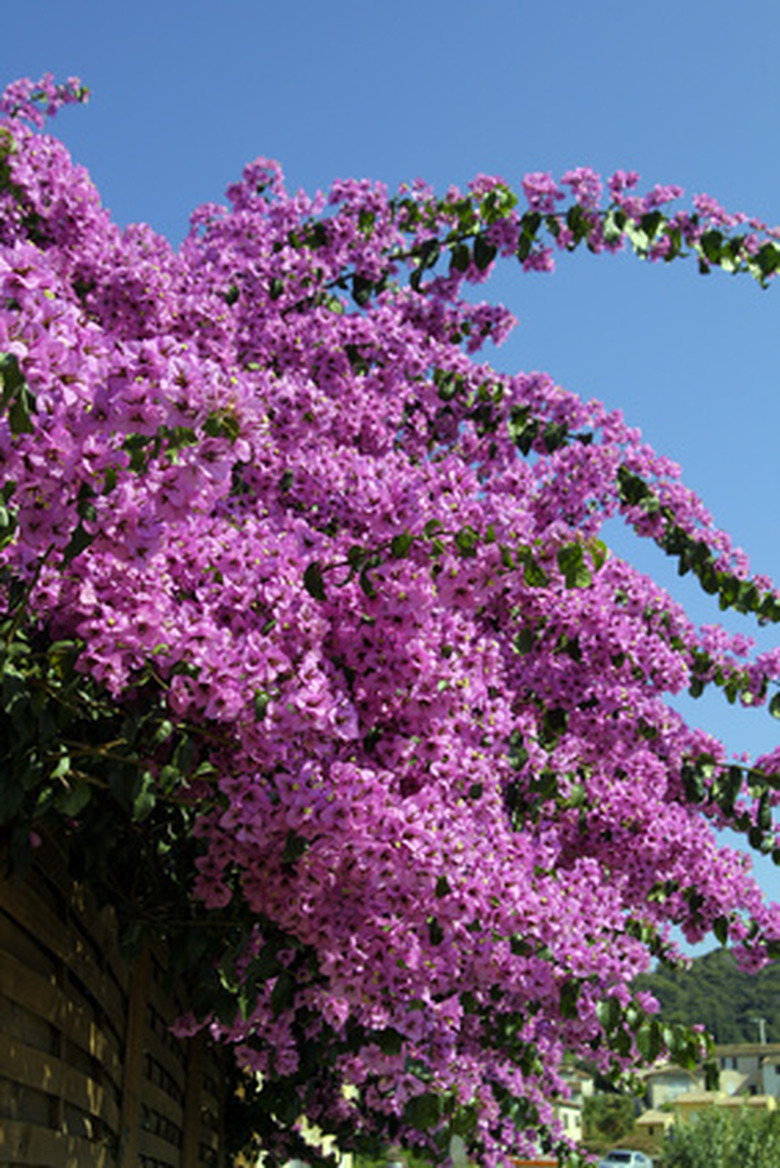Bougainvillea Care
The bougainvillea (Bougainvillea spectabilis) is an evergreen, woody vine that originated in Brazil. It is a climber that can be trained as a bushy pot plant, a hanging basket or as a plant 3 to 4 feet high. The vibrant color of bougainvilleas comes from the three large, paper-like bracts that surround the tubular white flowers.
Growing in a Pot
Bougainvilleas like lots of sun and a relatively dry climate. Grow bougainvilleas in a pot if there is a risk of frost in your growing zone. Use any good potting mix that drains well; do not allow bougainvilleas to sit in water. Outdoors, plant bougainvilleas in 5- to 10-gallon clay containers, which tend to stay dryer. Indoor pots can be smaller. If you grow them in hanging baskets, a 12-inch basket is good.
- The bougainvillea (Bougainvillea spectabilis) is an evergreen, woody vine that originated in Brazil.
- Outdoors, plant bougainvilleas in 5- to 10-gallon clay containers, which tend to stay dryer.
Don't rush to re-pot bougainvilleas when they look like they have outgrown one. As long as you water and fertilize them, restricting their root system won't hurt them, and they will produce more flowers. When you do move a plant, the new container should be no more than 2 inches larger.
Growing Outdoors
If you live in a frost-free growing zone and have the space, bougainvilleas planted in the ground can produce a spectacular display of blooms. Bougainvilleas like lots of sun and do best in a loamy, well-drained soil that is equal parts of sand, clay and silt. Planted outdoors, they tend to grow rampantly and may fail to produce blooms for one or two years. Plant your bougainvilleas on high ground if possible so water drains away from the roots.
- Don't rush to re-pot bougainvilleas when they look like they have outgrown one.
- If you live in a frost-free growing zone and have the space, bougainvilleas planted in the ground can produce a spectacular display of blooms.
Watering
Once established, bougainvilleas are drought tolerant. Wait until the soil is visibly dry before you water, then water thoroughly. You can make reluctant bougainvilleas produce more blooms by letting then dry slightly between watering. The trick is to let the plants wilt slightly, without damaging them, between watering. When the flower buds appear, usually in three or four weeks, resume watering. If you let them wilt too much, they will drop flowers.
Pruning
You can train bougainvilleas on a trellis, let them sprawl and trail, or keep them bushy. If you prune them constantly to keep them from growing, they will produce fewer blossoms. Bougainvilleas only produce blooms on new growth. Unless you prune them, they will grow outward without creating branches. Prune them hard at the beginning of summer and all summer to maintain their size. Prune them hard if they grow too much. To encourage the growth of new branches and the production of more blooms, pinch a half-inch from the tip of soft new stems. Bougainvilleas have four-week flowering cycles. Prune or pinch them after the flush of color is finished.
- Once established, bougainvilleas are drought tolerant.
- If you let them wilt too much, they will drop flowers.
Fertilizing
Bougainvilleas have thin, delicate roots. Fertilize with a 6-6-10 quick-release fertilizer that contains at least 5 percent iron plus other micronutrients. Fertilizer marketed for hibiscus also works well. Apply according to the directions on the label. If your plant grows too fast, producing large, dark-green leaves, you have likely applied too much fertilizer.
